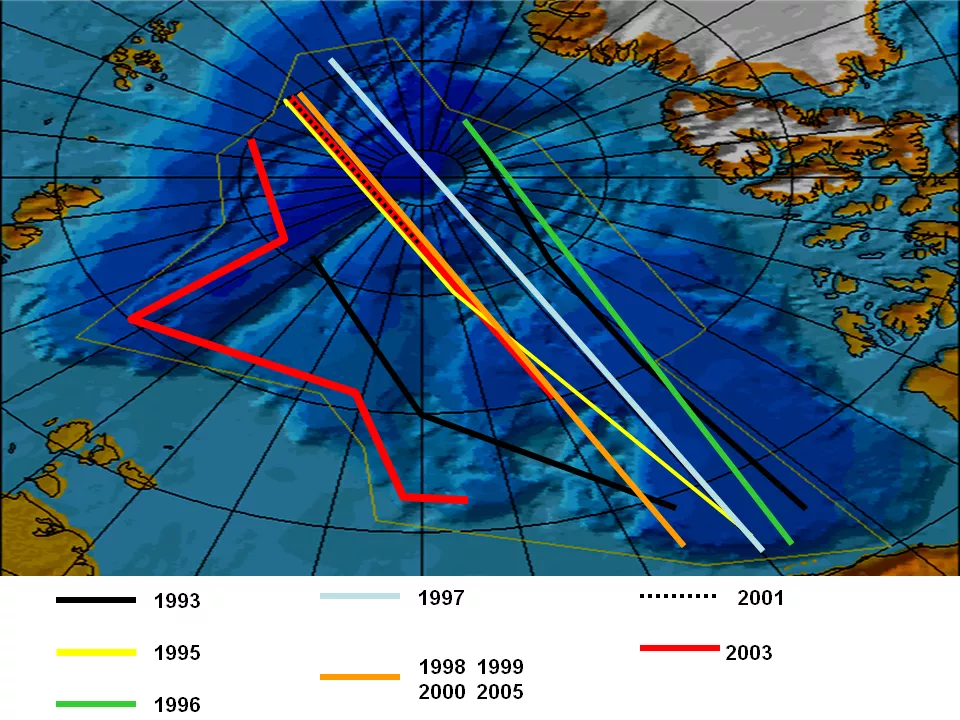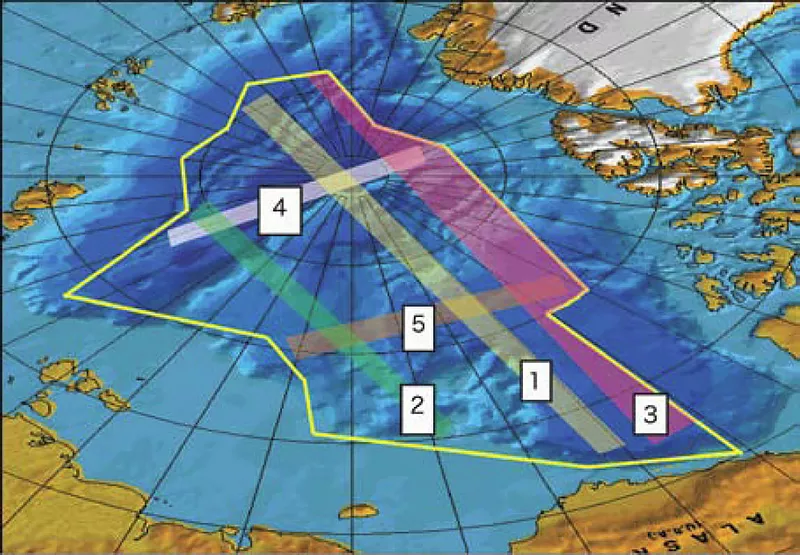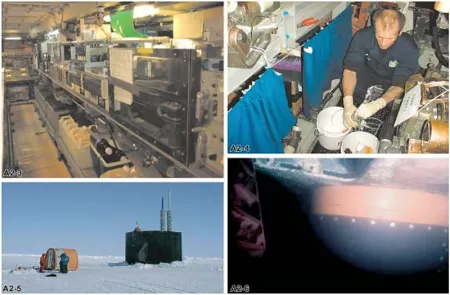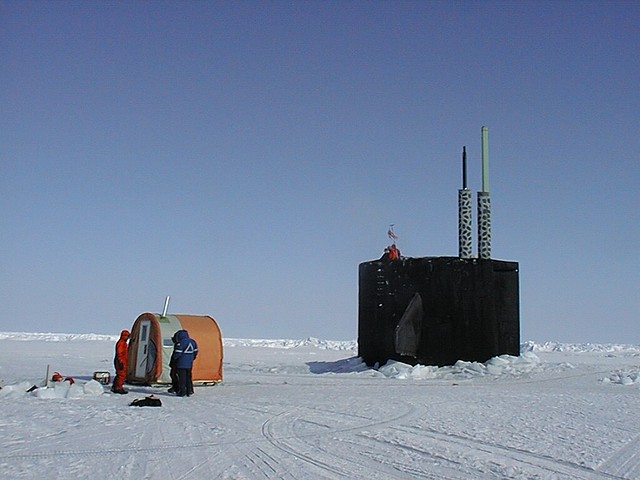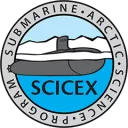
SCICEX: Submarine Arctic Science Program
About
The Submarine Arctic Science Program, SCICEX, is a federal interagency collaboration among the operational Navy, research agencies, and the marine research community to use nuclear-powered submarines for scientific studies of the Arctic Ocean. Unlike surface ships, submarines have the unique ability to operate and take measurements regardless of sea ice cover, weather conditions, and time of year. This allows for a broad and comprehensive investigation of an entire ocean basin. The goal of the program is to acquire comprehensive data about Arctic sea ice, water properties (biological, chemical, and hydrographic), and water depth (bathymetry) to improve our understanding of the Arctic Ocean basin and its role in the Earth's climate system.
SCICEX articles in the Spring 2015 issue of ARCUS's Witness the Arctic
- Teaching an Old Submarine Data Collection Program New Tricks
- A Labor of Love Brings Together Civilian Scientists and the U.S. Navy
SCICEX was officially launched in 1994 after a successful feasibility test in 1993 where civilian scientists joined Navy personnel on a submarine to acquire scientific data. From 1995–1999, five more dedicated science cruises were completed aboard nuclear-powered submarines. Since then, a modified approach has been taken, where some time is set aside for the collection of unclassified scientific data during otherwise classified submarine exercises. These are known as Science Accommodation Missions (SAMs) which are facilitated by the Arctic Submarine Lab (ASL). Guidance on data collection priorities during a SAM is provided in the SCICEX Phase II Science Plan. The most recent SAM took place in November 2018. See a list of all the SCICEX Cruise Dates.
This site is supported by the National Science Foundation (NSF) award number 0632296 for the Arctic Observing Network (AON) and by the Office of Naval Research (ONR) and the U.S. Arctic Research Commission (USARC). SCICEX is a Navy contribution to AON, the observational change component of a federal interagency committee called the Study of Environmental Arctic Change (SEARCH).
Current ONR awards
SCICEX Data Stewardship
PI: Florence Fetterer
Institution: University of Colorado Boulder
Open-water Test of Submarine-launched Expendable CTDs
PI: Jeff Gossett
Institution: US Navy Arctic Submarine Laboratory
Validation of Biogeochemical Measurements in the Arctic Ocean from Virginia and Sea Wolf Class Submarines
PI: Ray Sambrotto
Institution: Columbia University
Study of the impact of submarine operations on sea-ice draft measurements
PI: Mark Wensnahan
Institution: University of Washington
Contact information
Data access and availability: Ann Windnagel
SAC and SCICEX program: Jackie Richter-Menge
Research opportunities, ONR, IAC: Scott Harper
Oral history by George Newton
A recount of the history of SCICEX by George Newton, retired chairman of and current acting advisor to the U.S. Arctic Research Commission. George conceived of the SCICEX program in the early 1980's and helped to bring the program to fruition through the 90's and continues to support it to the present.
SCICEX History Interview, 45 minutes (mp3, 41.2 MB)
Transcript of Interview (pdf, 128 KB)
For a list of papers by George Newton mentioned in this interview see the Publications page.
SCICEX cruise history
Submarines have been employed for science since the 1920's when the Dutch began taking gravity measurements at sea (Edwards and Coakley, 2003). Submarines were first utilized for data collection under the Arctic ice pack in the 1950's, but these data were often classified. With the end of the Cold War, the submarine fleet had fewer operational tasks, so it became possible to consider bringing civilian scientists onboard to collect observations that would be immediately available for analysis.
In 1993, the United States Navy and the Arctic marine research community undertook a scientific research cruise aboard a nuclear-powered submarine in an ambitious program to evaluate the use of nuclear powered submarines for scientific studies of the Arctic Ocean. With the success of the initial project in 1993, the U.S. Navy, the National Science Foundation (NSF), the National Oceanic and Atmospheric Administration (NOAA), and the U.S. Geological Survey (USGS) signed a Memorandum of Agreement (MOA) in 1994 that launched the program that became known as SCICEX. The MOA called for annual dedicated SCICEX missions, which took place in 1995, 1996, 1997, 1998, and 1999. The project was initially called the "Science Ice Exercise," hence the acronym SCICEX, but was changed to the more descriptive "Submarine Arctic Science Program" in 2012.
In October of 1998, due in large part to a drastic reduction in the size of the nuclear submarine fleet, the U.S. Navy announced that they could no longer facilitate the dedicated scientific missions following the scheduled 1999 cruise. In an effort to continue the SCICEX program, the Navy and the science community agreed to a SCICEX Phase II MOA that would allow time to be set aside for the collection of unclassified data during otherwise classified submarine exercises, but did not include civilian scientists to embark. These were coined Science Accommodation Missions (SAMs). Four SAMs were completed in 2000, 2001, 2003, and 2005. With the release of the SCICEX Phase II Science Plan, Part 1 in July 2010, more routine opportunities to collect SCICEX data during a SAM are expected. The first of these took place in March 2011.
The 2010 Phase II Science plan provides the U.S. Navy with a detailed list of priorities for SAMs, including measurements of sea ice thickness, ocean hydrography, biology and chemistry, and bathymetry. The plan is built around five sampling corridors within an agreed upon SCICEX Data Release Area (DRA). See yellow outline in the figure below right or download the DRA coordinates. Using the science plan as a guide, the Navy's Arctic Submarine Laboratory (ASL) works with the operational Navy to identify and plan SCICEX SAM opportunities.
In 2010, NSIDC began the process of collecting and collating all of the SCICEX data to date and is working with the SCICEX Science Advisory Committee (SAC), the Arctic Observing Network (AON) Cooperative Arctic Data and Information Service (CADIS), as well as data management partners at Lamont-Doherty Earth Observatory (LDEO) and the National Geophysical Data Center (NGDC) on these tasks.
SCICEX instrumentation
When SCICEX began in 1993, the sensors available for data collection were limited to those currently installed on the submarine, those that had already been installed on similar submarines, or sensors that could be integrated without any modification of the submarine's structure or systems. As SCICEX evolved, on-board instrumentation was tailored to fit the research goals of each survey and capitalize on the operational capabilities of Sturgeon-class submarines (Edwards and Coakley, 2003).
The combination of sensors deployed during the dedicated SCICEX surveys collected an unprecedented combination of cryogenic, oceanographic, and geologic data, creating a multidisciplinary time series for the Arctic Ocean that has yielded, and will continue to yield, significant results for years. Sensors used during SCICEX fall into three main categories: instruments deployed from a submarine on the surface, instruments deployed from a submarine during under-ice operations, and surveying and sampling sensors that were installed onboard. The following table provides a list of the instrumentation used during the dedicated SCICEX missions. SAMs are limited to using instrumentation already onboard the submarine; they are noted with a * in the table below.
| Instrument | Description and Purpose |
|---|---|
| Submarine Data Recording System (SDRS) * | Captured information from a number of submarine sensors that consisted of time, position and orientation, and environmental information. |
| Submarine Remote Video Systems (SRVS) * | Low-light-level cameras attached to subs sail to monitor ice canopy . |
| Upward-looking sidescan sonar (ULS) * | Klein model-595 100 kHz sonars and Klein 2000 dual-frequency sonars to map the arctic sea ice canopy. |
| Digital Ice Profiling System (DIPS) | Digitize and record data from submarine's installed ice profiling sonar. |
| Conductivity, Temperature, Depth (CTD) (surface cast) | Sea-Bird SBE CTDs for measuring water properties. Casts are done at certain times when the submarine surfaces. |
| Conductivity, Temperature, Depth (CTD) (sail mounted) * | A CTD instrument is bolted to the submarine (on the hull or sail in this case) and collects data continuously as the submarine travels along. |
| Expendable Conductivity, Temperature, Depth (XCTD) sensors | Sippican XCTDs for measuring water properties. These instruments are cast while the submarine is at depth. |
| Through-hull water sampling | Water samples generally taken from an intake valve in the torpedo room that provide information on water chemistry such as dissolved oxygen, nitrates, and salinity. |
| Acoustic Doppler Current Profiler (ADCP) | RDI Instruments 150 kHz ADCP used to measure continuous current profiles. |
| Zero Angle Photo Spectrometer (ZAPS) | Used to measure dissolved organic carbon (used for SCICEX-97 only) |
| Seafloor Characterization and Mapping Pods (SCAMP) | Built specifically to map seafloor topography in three dimensions. Consisted of three instruments: Swath Bathymetric Sidescan Sonar (SSBS), High-Resolution Subbottom Profiler (HRSP), and the Data Acquisition and Quality Control System (DAQCS). SCAMP was used for SCICEX-98 and -99 only. |
| Gravimeter * | Bell Aerospace BGM-3 gravimeter for collecting underway gravity measurements. |
| Ship's Fathometer * | Narrow-beam high-resolution fathometer that collected bathymetric data. |
| Ship's Inertial Navigation System (SINS) * | Navigation sensor on most SCICEX cruises. |
| Electronically Suspended Gyro Navigation (ESGN) | Navigation sensor used in SCICEX-95. |
For a more detailed description of the instruments, see Edwards and Coakley (2003). * denotes that these instruments were already on board the submarine.
Importance of SCICEX
SCICEX data are important because they add critical pieces to the overall information needed to understand Arctic sea ice and ocean dynamics and to map the Arctic ocean floor. As a result NSF recognizes SCICEX as a Navy contribution to AON, the observational change component of a federal interagency committee called the Study of Environmental Arctic Change (SEARCH).
It is important to study the present-day Arctic Ocean so that we can understand its role in global climate change. During the 1990s, SCICEX scientists were some of the first to notice marked changes in the Arctic Ocean such as thinning of the arctic ice canopy and changes in water temperature (Edwards and Coakley, 2003). A unique and valuable feature of submarines is their ability to operate without respect to sea ice cover, weather conditions, or time of year, and they can also cross vast distances in a short amount of time. This allows for a broad and comprehensive investigation of an entire ocean basin (Edwards and Coakley, 2003). SCICEX has also contributed data to the International Bathymetric Chart of the Arctic Ocean (IBCAO) and NOAA's Pacific Marine Environmental Laboratory (PMEL) Atlas.
Data description
Sea Ice Draft
Profiles of sea ice draft obtained from the upward looking sonars of submarines transiting the Arctic Ocean have provided the bulk of our current knowledge of ice thickness over the Arctic basin. Early analyses of ice draft data compiled from one or more cruises revealed aspects of spatial ice thickness variability (Bourke and Garrett, 1987; Bourke and McLaren, 1992). These early analyses also initiated discussions about the possible thinning of the ice cover, even in the face of a limited knowledge of natural variability (McLaren et al., 1990; Wadhams, 1990; Shy and Walsh, 1996). With the subsequent declassification of ice draft data collected on many earlier cruises, as well as the availability of some ice draft data collected by submarines from the United Kingdom, interannual changes have been examined in greater detail. These analyses established that, indeed, the ice had thinned significantly within the Data Release Area between 1950–1970 and the 1990s (Rothrock, et al., 1999b; Yu et al., 2004).
It is likely that the submarine will continue to play a key role in an integrated strategy for monitoring ice thickness. Ideally, it will become more commonplace for SCICEX-derived ice thickness data to be effectively combined with data collected from satellite-borne instruments, moorings, ice mass balance buoys, and computer model simulations (Kwok and Rothrock, 2009). Submarines continue to provide the most accurate, detailed, large-scale thickness information. Although the submarine data are recognized to be temporally and spatially limited, they will continue to provide critical monitoring of the ice pack, and hence, data that are key for the validation and calibration of the satellite data and model output.
Ocean water properties
Hydrography
During the 15-year period since the beginning of the SCICEX program, our knowledge of the circulation and distribution of water mass properties within the upper layers of the Arctic Ocean has increased significantly. Yet, due to the Arctic's many scales of variability and continuing inaccessibility, we are still hard pressed to provide details on the variability of many of these features. Sail mounted Conductivity, Temperature, Depth (CTD) and expendable CTD (XCTD) data collected during the six dedicated-science SCICEX cruises contributed early to the awareness of variability in the peripheral flow of Atlantic Water.
These studies made use of the submarine's capability to make synoptic basin-spanning observations of the upper ocean temperature and salinity fields. The submarines were also used within the dedicated science program to conduct focused studies in specific regions and on specific processes, such as the Canada Basin eddy study of Muench et al. (2000). These experiments demonstrated the value of externally mounted chemical sensors in conditions where temperature and salinity alone are not sufficient to distinguish water mass origins (Guay et al., 1999). XCTD observations contributed to studies that focused primarily on upper ocean water analysis (Smith et al., 1999).
Chemistry
Chemical measurements have been used extensively to investigate physical and biological processes in the Arctic Ocean. Measurements were taken using hull mounted CTDs and discrete water samples. Numerous measurements were made on the SCICEX cruises of the 1990s, during which circulation patterns and time scales were investigated using transient tracers. Smethie et al. (2000) showed from tritium, helium-3, and chlorofluorocarbon measurements made on the 1996 SCICEX cruise that the central Canada Basin is ventilated with Atlantic Water on a time scale of one to two decades and that the oldest intermediate water in the Canada Basin was located in the northern end of the basin.
The Arctic Ocean is sensitive to the global rise in temperature and atmospheric carbon dioxide (CO2). One response has been a steady decrease in sea ice extent during summer. As the amount of open water increases, there is expected to be biogeochemical consequences, which could be documented along the SAM submarine tracks. Also, as a result of the enhanced CO2 uptake and the relatively low buffer capacity afforded by river and ice-melt-freshened Arctic Ocean surface waters, the Arctic is particularly vulnerable to ocean acidification. Models suggest that uptake of anthropogenic CO2 by Arctic Ocean surface waters will drive the largest and fastest pH decreases in all the world's oceans (Steinacher et al., 2008). This pH decrease has already and will continue to increase sound transmission in the circa 10 kHz frequency range (Hester et al., 2008). The implications of decreasing pH for organisms, particularly those that form calcium carbonate shells, are likely to be important and are only beginning to be understood (Doney 2006; Doney et al., 2009; Orr et al., 2005, 2009). With appropriate instrumentation, SCICEX SAMs can make a very important contribution to this issue by providing much-needed baseline data for relevant in situ sensed variables such as alkalinity, pH, and the partial pressure of CO2.
Biology
Ocean biology is concerned with the interaction of marine organisms and their environment. These interactions are the basis for evaluating the response of marine biota to environmental and climate variations and are key aspects for predicting the health of marine populations as well as potential changes in biogeochemical cycles (Anderson and Kaltin, 2001; Smetacek and Nicol, 2005; Bluhm and Gradinger, 2008).
All major taxonomic groups of organisms from microbes to fish and from birds to marine mammals are represented in the Arctic Ocean. The parallel physical and chemical observations within SCICEX provide an important ecological context for the biological measurements. Several research issues, such as ice cover, Arctic Ocean circulation, river/shelf/basin exchange, and the role and extent of eddies, cut across several disciplines and help to define the processes by which Arctic biological systems respond to climate change.
Biological sampling within the SCICEX program has focused mainly on microbial life due to its poorly understood diversity and its importance to the flows of nutrients and carbon (Falkowski et al., 2008). SCICEX sampling provided one of the first characterizations of the bacterial assemblages in the Arctic Ocean based on genetic sequence analysis (Bano and Hollibaugh, 2002). The SCICEX program can continue to contribute significantly to the growing information on the ocean's microbial diversity (Gross, 2007; DeLong, 2009).
Bathymetry
Despite the existence of detailed bathymetric maps of the northern polar region, such as the IBCAO (Jakobsson et al., 2008), much of the Arctic Basin has never been mapped using modern sounding techniques. This lack of data limits geological and geophysical investigations of the Arctic Basin; and because topography influences Arctic Ocean circulation, it also impacts oceanographic research. U.S. Navy nuclear-powered submarines played a critical role in acquiring bathymetric data for the Arctic. In particular, the SCICEX dedicated science missions systematically mapped portions of several of the major topographic provinces—Gakkel Ridge, Lomonosov Ridge, and Chukchi Borderland—that have been inaccessible to icebreakers because of perennial sea-ice cover (Edwards and Coakley, 2003).
SCICEX bathymetry and backscatter data collected in 1998 and 1999 contributed to two important paradigm shifts in understanding the Arctic Basin. First, that thick ice, either in the form of ice shelves (Polyak et al., 2001) or deep draft icebergs (Kristoffersen et al., 2004) had extended into the interior of the Arctic Basin during the Pleistocene, eroding shallow regions of the Alaska Margin, Chukchi Borderland, and Lomonosov Ridge. Second, Gakkel Ridge is volcanically active and may have erupted as recently as 1999, despite being the slowest-spreading mid-ocean ridge on Earth (Edwards et al., 2001; Müller and Jokat, 2001; Tolstoy et al., 2001). SCICEX data will certainly continue to add to our knowledge of the Arctic Basin well into the future.
The majority of the text on this page came from the SCICEX Phase II Science Plan Part I (2010) and Edwards and Coakley (2003).

